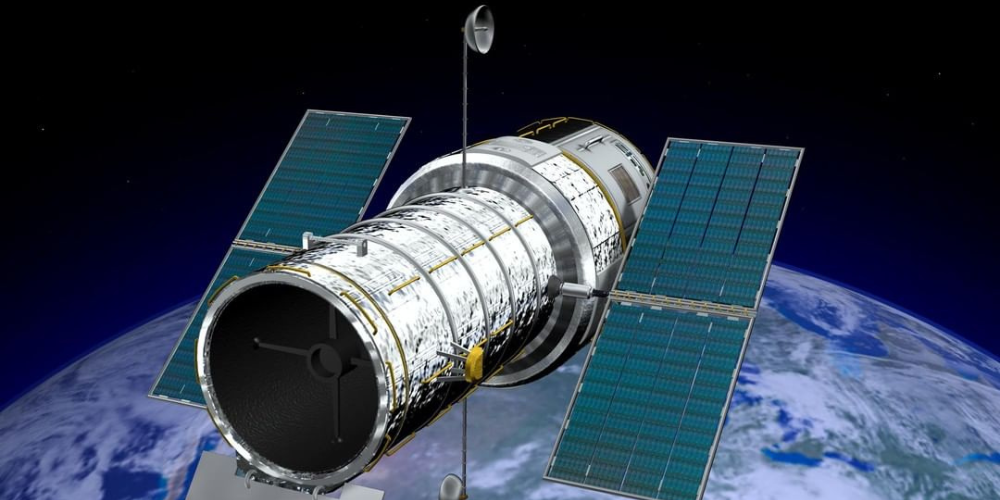
How Does the Hubble Telescope Work and Where Is It?

The Birth of the Hubble Telescope

Instagram | astroanajulia | The Hubble Telescope’s origin story: Dr. Lyman Spitzer Jr.’s 1946 vision for clearer cosmic images.
The story of the Hubble Telescope begins with Dr. Lyman Spitzer Jr., an astrophysicist who, in 1946, envisioned a telescope orbiting Earth to capture clearer images of the cosmos. Back then, space travel was still in its infancy, but Dr. Spitzer’s vision persisted. Over the next few decades, with the maturing of the U.S. space program, Spitzer lobbied NASA and Congress to make his dream a reality.
In 1975, the European Space Agency (ESA) joined forces with NASA to develop the telescope. Finally, in 1977, Congress approved funding for the project, and the telescope was named after Edwin Hubble, the astronomer whose observations of distant galaxies provided evidence for an expanding universe.
A Liftoff for Discovery
After years of construction and a delay due to the Challenger disaster in 1986, the Hubble Space Telescope finally launched in 1990. Carried aboard the space shuttle Discovery, it embarked on its journey to a unique vantage point above Earth’s atmosphere.
Since its deployment, the Hubble Telescope has transformed our understanding of the cosmos. Scientists have used its data to write countless research papers, piecing together the puzzle of the universe’s origin, age, and evolution. From studying colossal black holes to witnessing the fiery deaths of stars, Hubble has provided unparalleled insights.
How Does the Hubble Telescope Work?
But how does the Hubble telescope work and capture such breathtaking images? Here’s a breakdown of its key functionalities:
Capturing Light
Imagine a giant light collector – that’s what the Hubble Telescope is. It uses a specific type of mirror design called a Cassegrain reflector. Light enters the telescope through the open end and bounces off a large, curved primary mirror.
This reflected light then travels to a smaller, secondary mirror positioned near the top of the telescope tube. Finally, the light bounces off the secondary mirror and travels through a hole in the center of the primary mirror, reaching a focal point behind it.
Unveiling the Spectrum
At this focal point, specialized instruments take over. These instruments act like the “eyes” of the telescope, each designed to capture different wavelengths of light, similar to how our eyes perceive different colors. Unlike film cameras, Hubble uses electronic detectors called CCDs to capture this light information. The data is then converted into digital signals, stored onboard, and relayed to Earth for processing.
Here’s a closer look at some of Hubble’s key instruments:
- Wide Field Camera 3 (WFC3) – This versatile instrument captures both ultraviolet and infrared light, providing a broader view of the cosmos.
- Near Infrared Camera and Multi-Object Spectrometer (NICMOS) – This instrument delves into the infrared realm, allowing us to see objects obscured by dust and gas in visible light.
- Space Telescope Imaging Spectrograph (STIS) – By separating light into its component colors, STIS helps astronomers identify the chemical makeup of celestial objects.
- Advanced Camera for Surveys (ACS) – Installed during a servicing mission, the ACS observes visible light and has aided in mapping dark matter, spotting distant objects, and studying galaxy clusters.
- Fine Guidance Sensors (FGSs) – These sensors play a crucial role in keeping the telescope pointed at its targets.
Powering the Mission

Instagram | kevyn.rdz | Hubble telescope’s solar panels transform sunlight into power, while relay satellites ensure uninterrupted communication.
The Hubble Telescope isn’t a telescope, it’s a spacecraft. It requires power, communication with Earth, and the ability to adjust its orientation. Solar panels convert sunlight into electricity, and a network of relay satellites ensures seamless communication. Onboard computers manage these functions and steer the telescope toward its designated targets.
Limitations and the Enduring Legacy
Despite its remarkable capabilities, the Hubble Telescope has limitations. Its orbit restricts observations of objects close to the Sun, and it can’t observe the Sun itself due to the intense heat and light. Additionally, the telescope encounters high radiation zones that hinder data collection.
But, Hubble’s contributions to astronomy are undeniable. It has outlived its initial 15-year mission lifespan, thanks to several servicing missions that have repaired and upgraded its instruments. As long as Hubble remains operational and provides valuable data, it will continue to be a cornerstone of astronomical research.
A Successor Emerges

seekersofthecosmos | Instagram | James Webb Space Telescope boasts a larger mirror and advanced infrared tech for deeper cosmic exploration.
Hubble telescope’s sharp view has transformed our understanding of space. It captured light from distant objects, revealing the universe’s history and igniting scientific progress and public wonder. Even with newer telescopes, Hubble’s legacy will inspire future generations.
More in Tech
-
`
What Is Generative AI vs AI – And How Do They Differ?
In the ever-evolving landscape of artificial intelligence (AI), the line between science fiction and reality continues to blur. Chatbots seamlessly navigate...
June 28, 2024 -
`
What Quarters Are Worth Money? Tips to Identify Valuable Coins Today
In coin collecting, certain quarters stand out not just for their face value but for their potential worth, much beyond that....
June 21, 2024 -
`
5 Savings Accounts That Will Earn You the Most Money in 2024
In 2024, choosing the right savings account is more critical than ever. With the array of options available, knowing which savings...
June 5, 2024 -
`
The Complete Relationship Timeline of Taylor Swift & Travis Kelce
When you think of unlikely couples, Taylor Swift and Travis Kelce might not be the first pair that comes to mind....
May 29, 2024 -
`
What is Business Administration and What Opportunities Does it Offer?
In today’s bustling world of commerce and industry, the term “business administration” often looms large, yet its true essence remains shrouded...
May 22, 2024 -
`
What is AI? Exploring the World of Artificial Intelligence
In today’s rapidly evolving technological landscape, the term “Artificial Intelligence” (AI) has become a buzzword that sparks curiosity, speculation, and even...
May 16, 2024 -
`
How Many Jobs Are Available in Real Estate Investment Trusts? Exploring Career Opportunities
Are you seeking a career path with a blend of financial savvy and a knack for the real estate market? Look...
May 9, 2024 -
`
The Staggering Net Worth of the Richest Podcaster Joe Rogan in 2024
Joe Rogan has become a household name, largely due to his immensely popular podcast, “The Joe Rogan Experience.” With a blend...
April 29, 2024 -
`
What Are Routing Numbers & Do Credit Cards Have One?
When managing your finances, understanding the various numbers and terms associated with your bank accounts and credit cards is crucial. A...
April 24, 2024















You must be logged in to post a comment Login